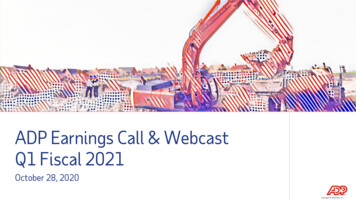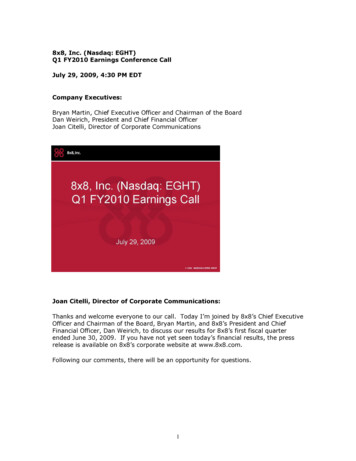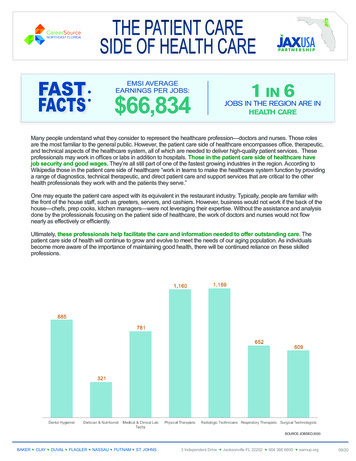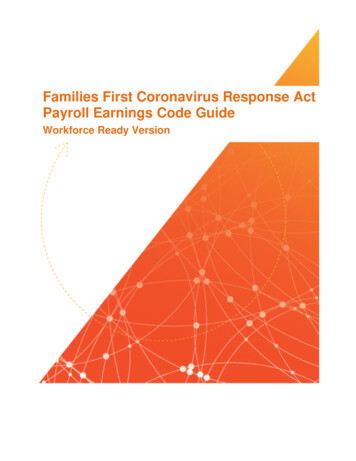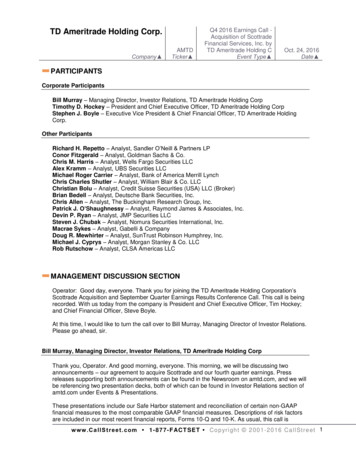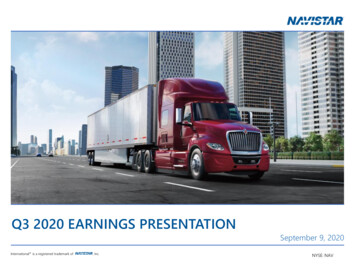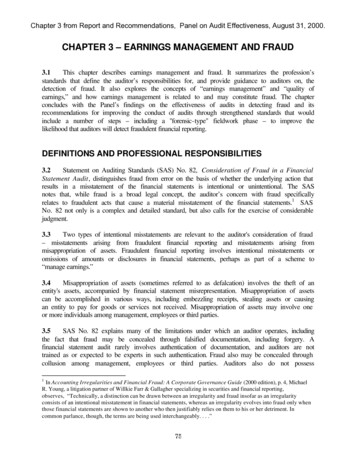
Transcription
Chapter 3 from Report and Recommendations, Panel on Audit Effectiveness, August 31, 2000.CHAPTER 3 – EARNINGS MANAGEMENT AND FRAUD3.1This chapter describes earnings management and fraud. It summarizes the profession’sstandards that define the auditor’s responsibilities for, and provide guidance to auditors on, thedetection of fraud. It also explores the concepts of “earnings management” and “quality ofearnings,” and how earnings management is related to and may constitute fraud. The chapterconcludes with the Panel’s findings on the effectiveness of audits in detecting fraud and itsrecommendations for improving the conduct of audits through strengthened standards that wouldinclude a number of steps – including a "forensic-type" fieldwork phase – to improve thelikelihood that auditors will detect fraudulent financial reporting.DEFINITIONS AND PROFESSIONAL RESPONSIBILITIES3.2Statement on Auditing Standards (SAS) No. 82, Consideration of Fraud in a FinancialStatement Audit, distinguishes fraud from error on the basis of whether the underlying action thatresults in a misstatement of the financial statements is intentional or unintentional. The SASnotes that, while fraud is a broad legal concept, the auditor’s concern with fraud specificallyrelates to fraudulent acts that cause a material misstatement of the financial statements.1 SASNo. 82 not only is a complex and detailed standard, but also calls for the exercise of considerablejudgment.3.3Two types of intentional misstatements are relevant to the auditor's consideration of fraud– misstatements arising from fraudulent financial reporting and misstatements arising frommisappropriation of assets. Fraudulent financial reporting involves intentional misstatements oromissions of amounts or disclosures in financial statements, perhaps as part of a scheme to“manage earnings.”3.4Misappropriation of assets (sometimes referred to as defalcation) involves the theft of anentity's assets, accompanied by financial statement misrepresentation. Misappropriation of assetscan be accomplished in various ways, including embezzling receipts, stealing assets or causingan entity to pay for goods or services not received. Misappropriation of assets may involve oneor more individuals among management, employees or third parties.3.5SAS No. 82 explains many of the limitations under which an auditor operates, includingthe fact that fraud may be concealed through falsified documentation, including forgery. Afinancial statement audit rarely involves authentication of documentation, and auditors are nottrained as or expected to be experts in such authentication. Fraud also may be concealed throughcollusion among management, employees or third parties. Auditors also do not possess1In Accounting Irregularities and Financial Fraud: A Corporate Governance Guide (2000 edition), p. 4, MichaelR. Young, a litigation partner of Willkie Farr & Gallagher specializing in securities and financial reporting,observes, “Technically, a distinction can be drawn between an irregularity and fraud insofar as an irregularityconsists of an intentional misstatement in financial statements, whereas an irregularity evolves into fraud only whenthose financial statements are shown to another who then justifiably relies on them to his or her detriment. Incommon parlance, though, the terms are being used interchangeably. . . .”75
Chapter 3 from Report and Recommendations, Panel on Audit Effectiveness, August 31, 2000.investigative powers, such as the power to subpoena witnesses and obtain evidence under oath.Furthermore, the evidence that auditors gather in an audit is often only persuasive; it is rarelyconclusive. And lastly, audits are designed to detect only material misstatements.3.6Accordingly, a financial statement audit performed in accordance with generally acceptedauditing standards (GAAS) is not a “fraud audit” or a detailed forensic-style examination ofevidence. Forensic audit procedures typically are performed on a limited number of accounts –as a separate engagement and not as part of an audit of financial statements performed inaccordance with GAAS – to determine the extent of a known or suspected fraud. In the absenceof such knowledge, even a forensic-type audit cannot guarantee that fraud will be detected. It iswidely believed that converting GAAS audits to fraud audits would ni volve costs far in excess ofthe foreseeable benefits to the public. SAS No. 82 recognizes that, because of the nature ofevidence generated in a GAAS audit and the characteristics of fraud, a GAAS audit providesonly reasonable, but not absolute, assurance that material misstatements will be detected.3.7Auditors are required to assess the risk of fraud in all audits. SAS No. 82 requires theauditor specifically to assess the risk of material misstatement from fraud; it indicates risk factorsthat the auditor should consider and provides guidance on how the auditor should respond to therisk assessment. The auditor has a responsibility “to plan and perform the audit to obtainreasonable assurance about whether the financial statements are free of material misstatement,whether caused by error or fraud.”3.8The general standard of due professional care requires the auditor to exercise professionalskepticism, which means having an attitude that includes a questioning mind and a criticalassessment of audit evidence. The standard states that “the auditor neither assumes thatmanagement is dishonest nor assumes unquestioned honesty.”2 This differs from the assumptionsnormally made by forensic auditors and investigators empowered by law. Forensic auditors, forexample, generally assume dishonesty unless there is evidence to the contrary.3.9SAS No. 82 categorizes risk factors related to fraudulent financial reporting. Among therisk factors are those related to management’s characteristics and influence over the controlenvironment, some of which relate to the motivation for management to engage in fraudulentfinancial reporting, and personal characteristics bearing on integrity and management style. SASNo. 82 also discusses risk factors specifically related to misappropriation of assets: thesusceptibility of assets to theft and the lack of controls designed to prevent or detectmisappropriations. It provides examples of risk factors in each of these two categories andguidance on other matters that auditors may become aware of that should be considered inassessing the risk of material misappropriation of assets.3.10 Many of the factors cited in SAS No. 82 are subjective and difficult to assess, and riskfactors may exist in circumstances where fraud does not. Even when risk factors are present, theauditor’s response to them is not definitively prescribed by the standard. SAS No. 82 states that“the auditor’s judgment may be that audit procedures otherwise planned are sufficient to respondto the risk factors.”2Some observers characterize this standard as proffering a “neutral” concept of professional skepticism.76
Chapter 3 from Report and Recommendations, Panel on Audit Effectiveness, August 31, 2000.3.11 The Auditing Standards Board (ASB) has commissioned research to evaluate theeffectiveness of SAS No. 82. The results of the research are expected to be available in 2000.3EARNINGS MANAGEMENT: THE CONTINUUM FROM LEGITIMACY TOFRAUD3.12 Reports and allegations of inappropriate earnings management were influential inprompting the Panel’s project, and the Panel devoted considerable attention to earningsmanagement.4Framing the Issue3.13 The term earnings management covers a wide variety of legitimate and illegitimateactions by management that affect an entity’s earnings. The Panel neither sought nor formulateda precise definition of earnings management.5 Rather, it sought to understand the phenomenonthat ranges from legitimate managerial activities at one end of the spectrum to fraudulentfinancial reporting at the other. It focused on the entire spectrum and how the auditor’s role inenhancing the credibility of financial information is affected by the different ways in whichearnings can be managed.3.14 Virtually all managerial activities have a potential effect on earnings, and in that senseconstitute earnings management; otherwise, the activities presumably would not be undertaken.Earnings management generally implies, however, that the activities undertaken are designed3In October 1998, the AICPA issued a Request for Research Proposals for an Assessment of SAS No. 82. The broadobjectives sought are to assist the ASB in its assessment of the effectiveness of SAS No. 82 and in its efforts toimprove related guidance by addressing how emerging businesses and technology affect the process of detectingmaterial misstatements caused by fraud.4In his speech, The “Numbers Game” (NYU Center for Law and Business, September 28, 1998), Arthur Levitt,Chairman of the Securities and Exchange Commission (SEC), remarked, “Well, today, I’d like to talk about anotherwidespread, but too little-challenged custom: earnings management. This process has evolved over the years intowhat can best be characterized as a game among market participants. A game that, if not addressed soon, will haveadverse consequences for America’s financial reporting system.”5The Panel is not aware of a single accepted definition of the term earnings management. In fact, differingcharacterizations or definitions of the term can be found. For example, in “Commentary on Earnings Management,”Accounting Horizons (December 1989), p. 92, Professor Katherine Schipper observes that “by ‘earningsmanagement’ I really mean ‘disclosure management’ in the sense of a purposeful intervention in the externalfinancial reporting process, with the intent of obtaining private gain (as opposed to, say, merely facilitating theneutral operation of the process).” In “A Review of the Earnings Management Literature and its Implications forStandard Setting,” Accounting Horizons (December 1999), p. 368, Professors Paul M. Healy and James M. Wahlenstate, “Earnings management occurs when managers use judgment in financial reporting and in structuringtransactions to alter financial reports to either mislead some stakeholders about the underlying economicperformance of the company or to influence contractual outcomes that depend on reported accounting numbers.” InAccounting Irregularities and Financial Fraud: A Corporate Governance Guide (p. 13) (see note 1), Michael R.Young describes the term as embracing two types of “managed earnings” and observes, “Now in talking aboutmanaged earnings, one has got to be careful. There are two types of managed earnings. One type is simplyconducting the business of the enterprise in order to attain controlled, disciplined growth. The other type involvesdeliberate manipulation of the accounting in order to create the appearance of controlled, disciplined growth –when, in fact, all that is happening is that accounting entries are being manipulated” (emphasis in original).77
Chapter 3 from Report and Recommendations, Panel on Audit Effectiveness, August 31, 2000.either to smooth earnings over two or more interim or annual accounting periods or to achieve adesignated earnings level, perhaps to meet securities analysts’ forecasts.63.15 Some earnings management activities involve legitimate discretionary choices of when toenter into transactions that require accounting recognition, not unlike legitimate year-end taxplanning decisions made to accelerate deductions or defer taxable income. For example,advertising expenditures, which generally should be expensed when incurred, may be acceleratedin the fourth quarter if the entity is exceeding its earnings target or deferred if it is failing to meetthat target. Other earnings management activities involve legitimate choices of how to accountfor transactions and other events and circumstances – particularly those involving accountingestimates and judgments – in conformity with generally accepted accounting principles (GAAP).For example, implementation of a decision to enhance the entity’s credit and collection activitiesmay legitimately support reducing the estimate of bad debt expense. These are legitimatemanagement decisions that affect reported earnings whose consequences are accounted for inconformity with GAAP.73.16 Earnings management also may involve intentionally recognizing or measuringtransactions and other events and circumstances in the wrong accounting period or recordingfictitious transactions – both of which constitute fraud. Choosing the appropriate period in whichto recognize a transaction requires both management’s and the auditor’s understanding of all therelevant facts and circumstances. For example, assume that an entity announces that – either inresponse to higher costs, to meet current-period sales targets or for any other reason – it willincrease prices at the beginning of the next quarter, thereby stimulating some customers topurchase unusually high quantities before the end of the current quarter. If the sales meet all thecriteria for revenue recognition, the entity should recognize the sales when the product isshipped, possibly resulting in an effective and legitimate management of earnings.8 If, however,there is an unusual right-of-return privilege and there is no basis for estimating the returns thatwill take place, the transaction essentially becomes a conditional sale, and recognizing therevenue when the product is shipped violates GAAP and misstates the financial statements. If theright-of-return privilege has been concealed from the auditor as part of a scheme to increasereported earnings, the financial statement misstatement involves fraudulent financial reporting.This suggests that the wide variety of earnings management activities, which cannot always beclassified easily, constitutes a continuum that ranges from complete legitimacy at one extreme tofraud at the other.The Quality-of-Earnings Concept in the Continuum3.17 Earnings manage
31.08.2000 · CHAPTER 3 – EARNINGS MANAGEMENT AND FRAUD 3.1 This chapter describes earnings management and fraud. It summarizes the profession’s standards that define the auditor’s responsibilities for, and provide guidance to auditors on, the detection of fraud. It alsoexplores the concepts of “earnings management” and “quality ofFile Size: 248KBPage Count: 25

